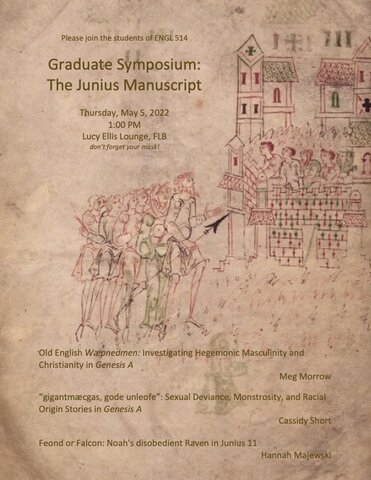18 April 2015
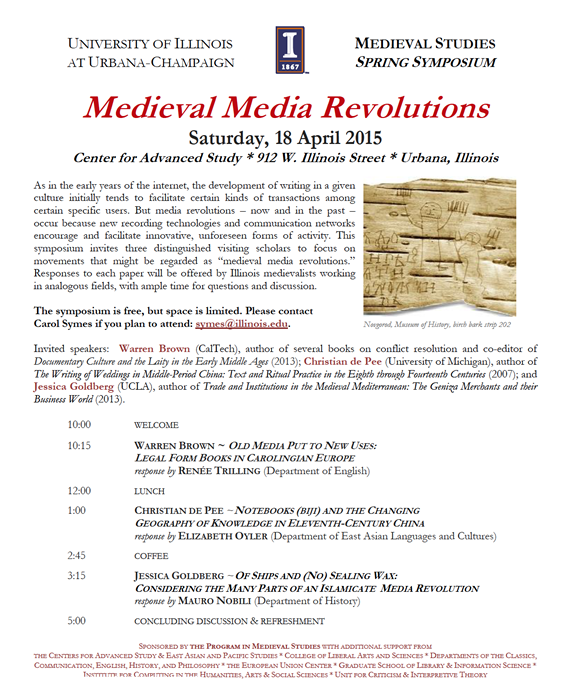
3 April 2015

29 January 2015
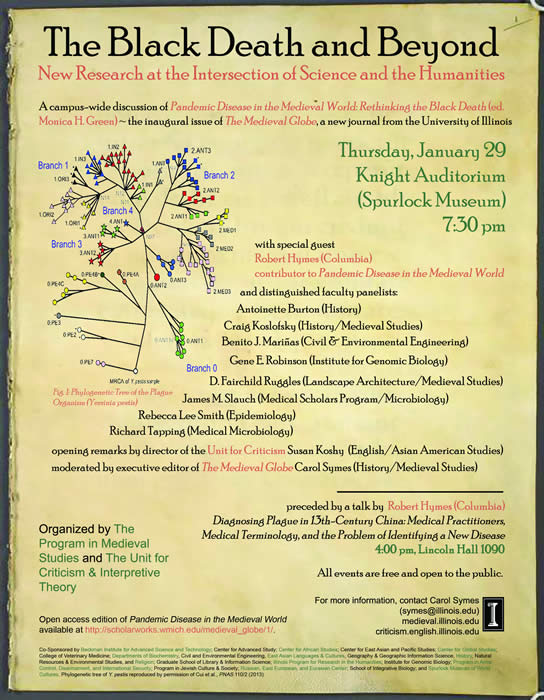
12 April 2014, Levis Faculty Center
Translated and directed by Ann Hubert
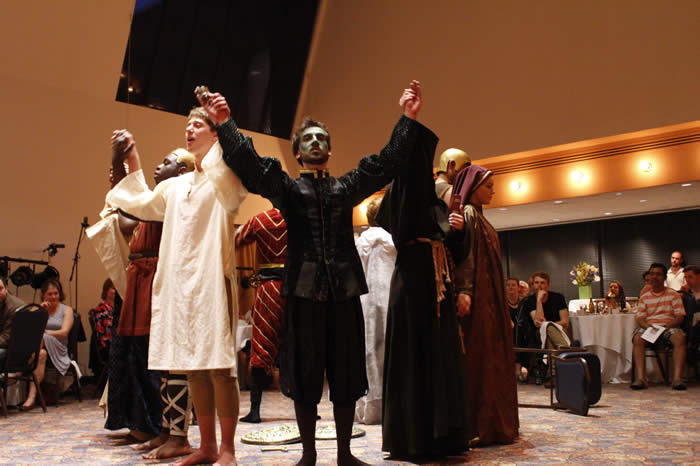
Cast
Saul/Paul.............................................................Jon Stricker
Poeta................................................................Erin Chandler
Ananias/Angel............................................Stephanie Svarz
Caiaphas..........................................................Shelby Garrett
Anna........................................................Samantha Moriarty
Servant to Caiaphas and Anna......................Joshua Lynch
Servant to Saul/Belial…………………...Tarek Nabulsi
Stable Boy/Mercury…………………….C.J. DeDivitis
First Soldier…………………. Ayzvara Suntharalingam
Second Soldier……………………….Janjay Knowlden
Voice of God……………………………..Jacob Serber
Crew
Costumes……….….........................The Krannert Center
Lights……………………………...New Revels Players
Special Effects………………………….......Jon Stricker
Director...............................................................Ann Hubert
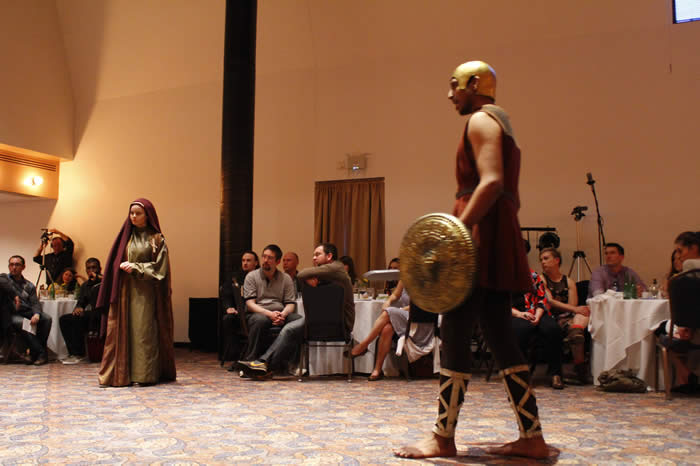
DIRECTOR’S NOTES
The Conversion of St. Paul is a medieval saint’s play written in the late fifteen/early sixteenth century in a region of England known as East Anglia (Norfolk and Suffolk). This play dramatizes the experiences of an early church figure, portraying his life first as the persecutor Saul and later as the convert and preacher Paul. Presented with a life-altering miracle on the road to Damascus, Saul must decide what path to travel when confronted by a personal and spiritual cross-roads.
The Conversion of St. Paul is one of only two extant medieval English saints’ plays. In the 1530s, England experienced religious unrest when King Henry VIII converted from Catholicism to Protestantism in order to divorce his wife, Catherine of Aragon. As a result, much Catholic iconography – statues, paintings, stained glass windows, and even plays – was destroyed throughout England. The Conversion of St. Paul survived because it emphasized religious change: the story of Saul’s conversion from Judaism to Catholicism was reinterpreted as a conversion from Catholicism to Protestantism, making the play a relevant and insightful tool reinforcing the cultural trend toward Protestantism.
The survival of The Conversion of St. Paul attests to the timelessness of drama, showing that every performance contributes an understanding to the original and current cultural context in which it is produced. These ideas about authenticity and anachronism inform this production. While I have adhered to the theatrical approach of “original practice” by staging this performance in the round as a dinner theatre, I have also selectively “modernized” segments to highlight ongoing tensions in religious discourse. We as a cast believe that our compromises between the fifteenth/sixteenth and twenty-first centuries authentically address layers of temporal context.
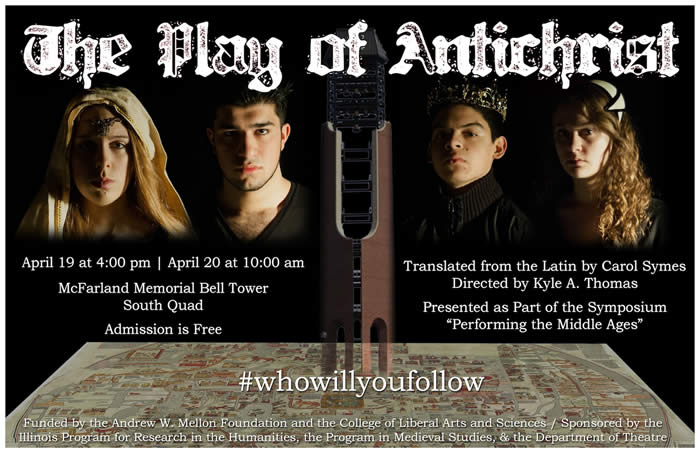
A pilot project "Performing the Middle Ages" received funding in 2013 as part of a planning grant awarded by the Andrew W. Mellon Foundation to the Illinois Program for Research in the Middle Ages for the "Humanities Without Walls" initiative. The "Performing the Middle Ages" project brings together scholars specializing in medieval performing arts from the University of Illinois at Urbana-Champaign as well as the University of Notre Dame, the University of Chicago, Indiana University, the University of Iowa, the University of Michigan, the University of Minnesota, Ohio State University, and Purdue University. Three performances were staged during the planning grant year 2013: the plays "Mankind" and "The Play of Antichrist" at the University of Illinois, and a Carthusian Vespers service at Notre Dame.
The members of the "Peforming the Middle Ages" teams are also developing plans for a future performance series integrating performances of medieval arts from across the globe with collaborative scholarly study and pedagogy. Planning meetings were held at the University of Illinois on 6 October 2012 and 20 April 2013.
The members of the Performing the Middle Ages planning teams are:
- Cara Aspesi (Univ. of Notre Dame)
- Robert W. Barrett (Univ. of Illinois)
- Anna de Bakker (Univ. of Notre Dame)
- Mark Bender (Ohio State Univ.)
- Gabriela Currie (Univ. of Minnesota)
- Margot Fassler (Univ. of Notre Dame)
- Li Guo (Univ. of Notre Dame)
- Ann Hubert (Univ. of Illinois)
- Reginald Jackson (Univ. of Chicago)
- Tala Jarjour (Univ. of Notre Dame)
- Nicolas Kamas (Univ. of Notre Dame)
- Hildegard Keller (Univ. of Indiana)
- Herbert Kellman (Univ. of Illinois)
- Joseph Lam (Univ. of Michigan)
- Michael Long (Indiana Univ.)
- Christopher Macklin (Univ. of Illinois)
- Rosemarie McGerr (Indiana Univ.)
- Elizabeth Oyler (Univ. of Illinois)
- Chan Park-Miller (Ohio State Univ.)
- Shelley Quinn (Ohio State Univ.)
- Brian Ruppert (Univ. of Illinois)
- Claire Sponsler (Univ. of Iowa)
- Andrea Stevens (Univ. of Illinois)
- Carol Symes (Univ. of Illinois)
- Kyle A. Thomas (Univ. of Illinois)
- Elizabeth Walch (Univ. of Illinois)
- Anne Walters Robertson (Univ. of Chicago)
- Sara Weisweaver (Univ. of Illinois)
- Paul Whitfield White (Purdue Univ.)
- Charles D. Wright (Univ. of Illinois)
Mankind
A dinner theatre performance directed by Kimberly Fonzo and Ann Hubert
19 April 6:30pm
Levis Faculty Center
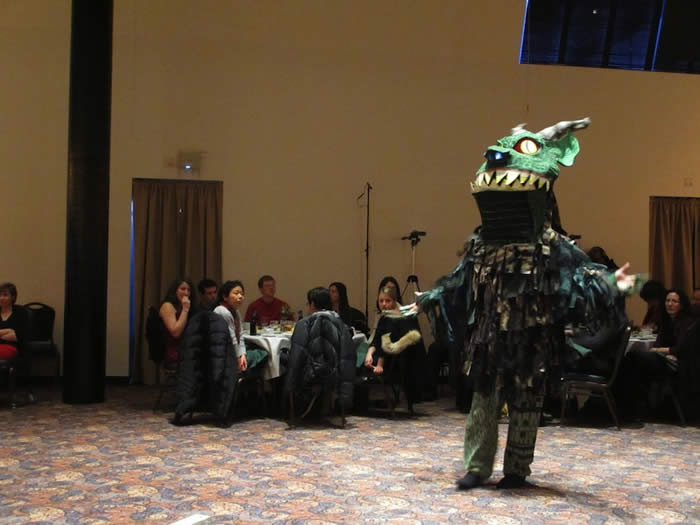
The Play of Antichrist (Ludus de Antichristo)
translated by Carol Symes; directed by Kyle A. Thomas
19 April 4:00pm & 20 April 10:00am
South Quad, UI Campus
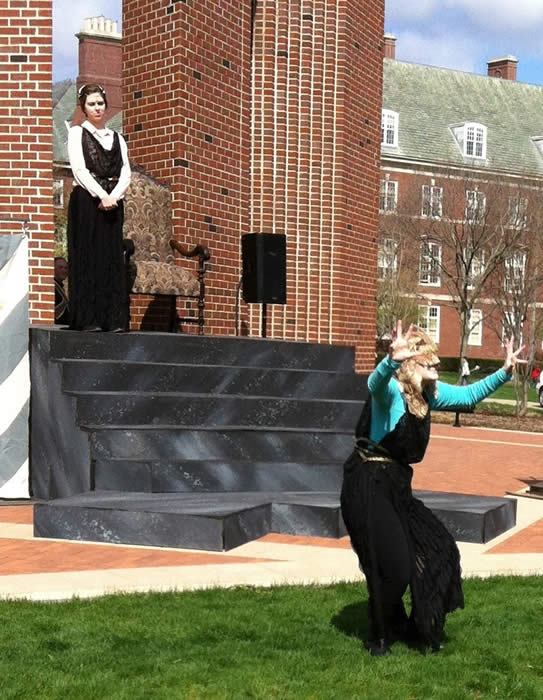
Josephine Lane (above) as Ecclesia
Elana Weiner-Kaplow (below) as Synagoga
(Jess Gersz, Costume Coordinator)
Carthusian Lauds Service
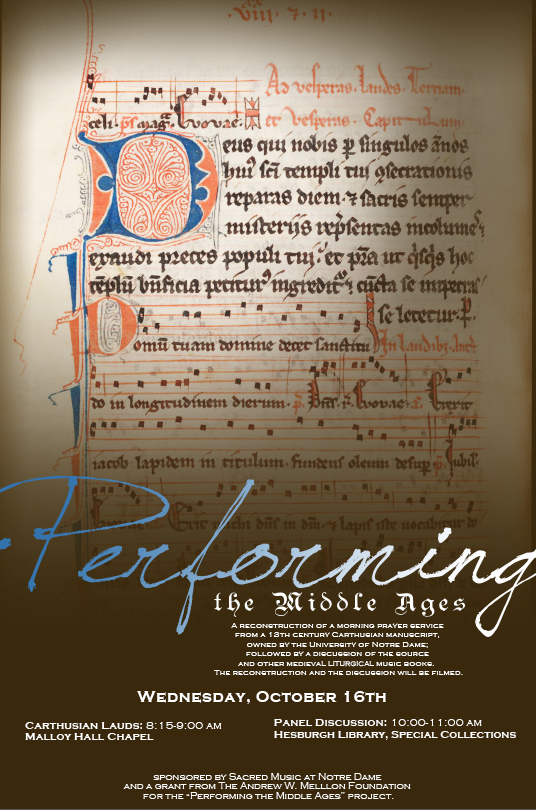
16 October
Univ. of Notre Dame
directed by Margot Fassler
12-14 April 2012
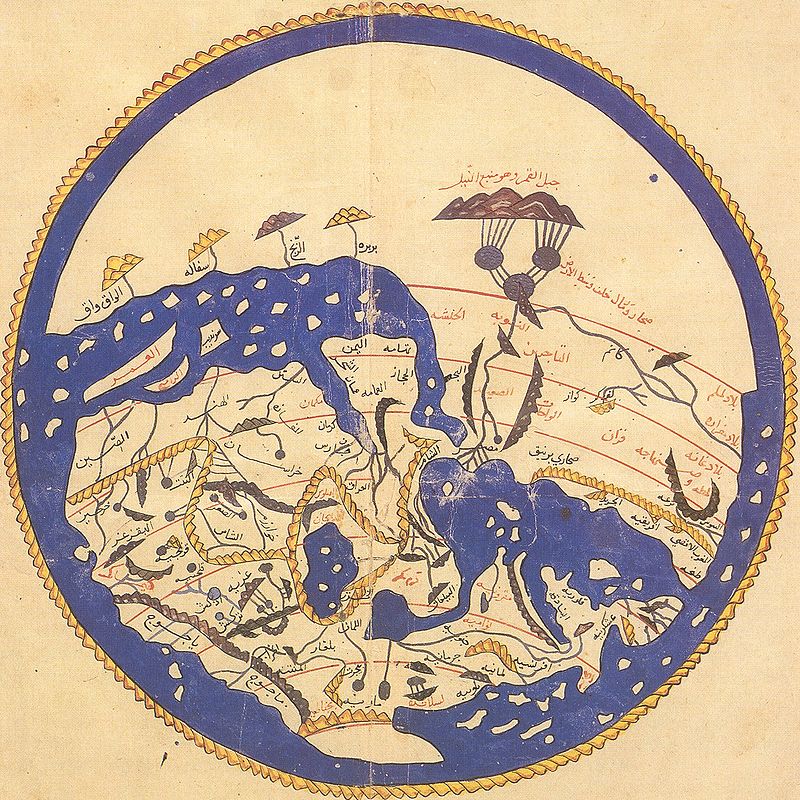
Featuring the work of prominent scholars who are transforming our understanding of the medieval world – and the myriad ways in which our own world has been shaped by its complex relationship to the Middle Ages – this conference will
- Explore modes of communication, media of exchange, and the myriad interconnections among medieval cultures
- Demonstrate that the study of the medieval world is central to the study of global human endeavor, by discussing the deep roots of global processes and by engaging the complicated ways that ideas about the past inform the present and shape visions of the future
- Enrich current perceptions of “medieval” (or “not modern”) peoples and phenomena, and to explore how “the Middle Ages” has been (and continues to be) constructed around the world and within a global context.
Speakers:
Jonathan Conant (Brown Univ.): “The Carolingians and the Ends of Empire”
Kathleen Davis (Univ. of Rhode Island) “Imagining the Past Globally: Questions and Possibilities for the Now and the Future”
Margot Fassler (Notre Dame) "Hildegard of Bingen's Cosmic Egg"
Geraldine Heng (Univ. of Texas at Austin) “Early Globalities: Projects, Questions, Methods”
Linda Komaroff (Los Angeles County Museum of Art) “Genghis Khan Faces West: Transmission and Dissemination of a New Visual Language”
Sharon Kinoshita (Univ. of California Santa Cruz) “Worlding Marco Polo”
Elizabeth Lambourn (De Montfort Univ.)
Carla Nappi (Univ. of British Columbia) “Translating the Medieval World”
Elizabeth Oyler (Department of East Asian Languages and Cultures, UIUC) “Specters and Otherworlds in the Noh Play Tsunemasa”
Michael Puett (Harvard Univ.) “Understanding Early Medieval China in a Eurasian Context”
Christian Raffensperger (Wittenberg Univ.) “Who's Afraid of Macrohistory? The Joys and Pains of Crossing Traditional Boundaries in History Research and Writing.”
D. Fairchild Ruggles (Department of Landscape Architecture, UIUC) “Architecture, Agency, and Assassination: Mamluk Turks in 13th-14th-Century Egypt.”
Eleonora Stoppino (Department of Spanish, Italian, and Portuguese, UIUC) “Paper Travelers: Fictions of the Medieval Globe.”
Nicolás Wey-Gómez (California Institute of Technology) “Martin Behaim's Globe: Cosmography, Economics, and the Quest for Globalization in the Latter Middle Ages (1492)”
October 9-10, 2013, Levis Center
This conference brings together leading scholars in the field from North America and Japan for a two-day symposium to examine the relationship between metropole and rural religious performance by drawing a set of clear lines of liturgical practice in the East Asia case, with special reference to Japan. The keynote speakers will be Professors Matsuo Kōichi, National Museum of Japanese History, and Haruo Shirane, Columbia University. First, we pay attention to the position of medieval Japanese religious performance vis-à-vis continental East Asia. What were the ritual and cultural flows that informed the development of medieval Japanese Buddhist and other religious performance (Kami worship, Shugendō [mountain asceticism])? Second, we consider the character and movement of a series of religious performances in the Japanese isles. What were the producers and audiences of these performances? How, moreover, were these performative modes translated between groups in the metrapole and countryside? Third, how did performance genres such as divine dance (kagura) and visual didactic performance (etoki) influence religious performance and reception through their mixture of multiple media? Finally, how did the mobility of performers and media influence the development of religious performance? For example, how did the travel of a figure like the monk Ennin to China influence his production of shōmyō chanting in Japan? What does archeological study tell us about the movement of Pure Land Buddhist performative practices? How did performances of Kumano believers and Shugendō practitioners transmit or otherwise transform their practices in currents between metropole and mountainside? Furthermore, how were textual-performative practices related to temple arts and ritual transmission in the city and country?
Cultural Transmission in Medieval East Asia:
A Workshop on East Asian Medievality
22 October 2011, 9:00am-4:00pm
101 International Studies Bldg.
Co-sponsored by the Department of East Asian Languages and Cultures

Speakers:
Zong-qi Cai (UIUC), “The Early Philosophical Discourse on Language and Reality and Lu Ji’s and Liu Xie’s Theories of Literary Creation.”
Hwisang Cho (Columbia Univ.), “The Expansion of Epistolary Space in Sixteenth-Century Korea.”
Naomi Fukumori (Ohio State Univ.), “The Kamo Festival: Reception and Transmission of Imperial Ritual in Heian-period Women-authored Texts”
Meow Hui Goh (Ohio State Univ.), “Old Wine in New Bottles: The Compositional Process in Early Medieval Chinese Literature.”
Alexander Mayer (UIUC), “Cultural Transmission: The Topology of Actor and Place in the Writings on Xuanzang’s Life.”
Brian Ruppert (UIUC), “The Monk Saisen (1025-1115) and the Creation of the Medieval Kobo Daishi (Kukai).”
Fall Symposium 2010
Saturday, 6 November 2010
Speakers:
Laura Whatley (UIUC/University of Tennessee at Knoxville), "Visualizing Jerusalem and Crusade in Medieval England"
Janet Marquardt (Eastern Illinois University), "From Early Christian to Neo-Romanesque: Finding Medieval Art in Ireland and France"
Martino Rossi Monti (Università degli Studi di Firenze), "Visions of Grace: The Legend of Saint Luke and Raphael's Dream"
Rachel Stocking (Southern Illinois University), "Braulio of Saragossa and Pope Honorius: Seventh-Century Iberian Anti-Judaism in a Mediterranean Context"
Valerie Garver (Northern Illinois University), "Gifts of Textiles and Clothing in the Carolingian World"
Megan McLaughlin (UIUC), "The Case Against Clerical Wives"
Stephen Jaeger (UIUC), "Alcuin and the Music of Friendship"
Carol Symes (UIUC), "Who Killed Greek Tragedy? The Myth of the Murderous Middle Ages"
Beth Williamson (University of Bristol), "Inner Senses and Outer Senses: Sound and Image"
Shawn Boyd (University of North Dakota), "What Stands Before Them (And Us)? Das Fremde and the Nibelungenlied"
Stephanie Clark (UIUC), "Theorizing Anglo-Saxon Prayer"
Donna Bussell (University of Illinois, Springfield), "Cicero, Aelred, and the Politics of Love in Clemence of Barking’s Catherine Legend"
Susan E. Deskis (Northern Illlinois University), "Alliterative Adaptations in Middle English Proverbs"
Martin Camargo (UIUC), "The Late Fourteenth-Century Renaissance of Anglo-Latin Rhetoric"
Twenty Years of American Medievalism:
A Symposium
Monday, October 6, 2008 - Levis Faculty Center
Tuesday, October 7, 2008 - Illini Union (Room 406)
program [PDF, 269kb]
Translating the Middle Ages
Tuesday & Wednesday, October 28-29, 2008
Illini Union (Room 210)
Past Events Lists
Fall 2014
Spring 2014
Fall 2013
Spring 2013
Fall 2012
